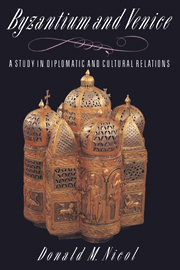Book contents
- Frontmatter
- Contents
- Dedication
- Preface
- List of abbreviations
- Maps of the Byzantine and Venetian worlds
- 1 Venice: the Byzantine province
- 2 Venice: the Byzantine protectorate
- 3 Venice: the ally of Byzantium
- 4 Venice: the partner of Byzantium
- 5 Byzantium, Venice and the First Crusade
- 6 The parting of the ways
- 7 The calm before the storm
- 8 The Fourth Crusade
- 9 Venice in Byzantium: the Empire of Romania
- 10 Venice: champion of a lost cause
- 11 Byzantium, Venice and the Angevin threat
- 12 Byzantium, Venice and Genoa
- 13 Conflicting interests and competing claims
- 14 Byzantium, Venice and the Turks
- 15 Byzantium: the victim of commercial rivalry
- 16 The profit and honour of Venice
- 17 Jewels for an island
- 18 Byzantium in thrall to the Turks and in debt to Venice
- 19 Byzantine optimism and Venetian vacillation
- 20 Byzantium the suppliant of Venice
- 21 The worst news for all of Christendom: Venice and the fall of Constantinople
- 22 Legacies and debts
- Byzantine Emperors
- Doges of Venice
- Bibliography
- Index
15 - Byzantium: the victim of commercial rivalry
Published online by Cambridge University Press: 01 April 2010
- Frontmatter
- Contents
- Dedication
- Preface
- List of abbreviations
- Maps of the Byzantine and Venetian worlds
- 1 Venice: the Byzantine province
- 2 Venice: the Byzantine protectorate
- 3 Venice: the ally of Byzantium
- 4 Venice: the partner of Byzantium
- 5 Byzantium, Venice and the First Crusade
- 6 The parting of the ways
- 7 The calm before the storm
- 8 The Fourth Crusade
- 9 Venice in Byzantium: the Empire of Romania
- 10 Venice: champion of a lost cause
- 11 Byzantium, Venice and the Angevin threat
- 12 Byzantium, Venice and Genoa
- 13 Conflicting interests and competing claims
- 14 Byzantium, Venice and the Turks
- 15 Byzantium: the victim of commercial rivalry
- 16 The profit and honour of Venice
- 17 Jewels for an island
- 18 Byzantium in thrall to the Turks and in debt to Venice
- 19 Byzantine optimism and Venetian vacillation
- 20 Byzantium the suppliant of Venice
- 21 The worst news for all of Christendom: Venice and the fall of Constantinople
- 22 Legacies and debts
- Byzantine Emperors
- Doges of Venice
- Bibliography
- Index
Summary
In the last year of the Byzantine war for possession of the throne the Genoese stopped supplying corn to Constantinople, partly as a reprisal for the sinking of two of their ships. They boasted that they alone could determine whether the city's inhabitants survived or starved, since they could get corn from no other source. The boast was not strictly true so long as Venetian ships came in from the Black Sea. But the new emperor, John Cantacuzene, knew well enough what they meant. He knew too that, while the Genoese had taken no active part in the fighting that had brought him to his throne, their sympathies were with his opponents, the Empress Anne of Savoy and her family. They had also turned the confusion of the war to their own advantage by reoccupying the island of Chios and the mainland ports of Phokaia which Andronikos III had reclaimed in 1329. Cantacuzene had more to fear from the Genoese than from the Venetians. The activities of the Venetian residents in Constantinople could be watched and to some extent controlled. The Genoese colony of Galata across the Golden Horn was an autonomous enclave beyond the control of the emperor and his officials, setting its own tariffs and collecting its own dues. In 1348 it was estimated that the annual revenue of Galata was nearly seven times that of Constantinople. When, as a matter of form, the Genoese asked permission to enlarge and refortify their settlement the emperor refused. They took no notice and did as they wished.
- Type
- Chapter
- Information
- Byzantium and VeniceA Study in Diplomatic and Cultural Relations, pp. 264 - 282Publisher: Cambridge University PressPrint publication year: 1989



